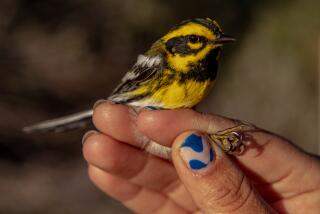Eponyms Bequeath a 2nd Life on Names : Language: The diesel, the sax and bloomers all derive their names from people who end up achieving an immortality of sorts.
- Share via
They are departed now, one and all:
Rudolf Diesel. Antoine Sax. Amelia Jenks Bloomer. William Russell Frisbie. Jules Leotard. Danile C. Stillson.
But glory, glory, hallelujah, their names go marching on. Theirs is immortality achieved by eponym: some thing named for some body .
Diesel’s engines make the world go ‘round under his name. This is fortunate. His first patent for them issued Feb. 28, 1892, was for an Arbeitsver fahren und Ausfuhrungsart fur Verbrennungskraftmaschinen (combustion power engine), which is an eponym to break jaws with.
The four-slotted screws of Henry F. Phillips hold much of the world together, while the adjustable wrench invented in the 1800s by Stillson tightens what’s loose.
Of the legacy of Monsieur Sax (1814-1894), a Belgian maker of music and musical implements, it has been said: “A gentleman is he who knows how to play a saxophone and doesn’t.”
Immortality by eponym is accidental, rarely by design.
W.R. Frisbie modestly stamped his name on pie plates that issued in the 1870s from his bakery in Bridgeport, Conn. He had no inkling those skimmable pie tins which bore his name would become a tradition at Yale University among tin-tossing students and would, years later, catch the eye of the Wham-O Manufacturing Co. in search for a name for its plastic discs. Despite a slight misspelling, W.F. Frisbie sails through the air somewhere on Earth daily.
Fitzroy James Henry Somerset, Lord Raglan, illustrates the unpredictability of eponymy. He lost an arm at Waterloo, telling his amputators: “Here, don’t take that arm away until I get my ring off the finger.” He commanded the British in the Crimean War and their boneheaded charge of the Light Brigade. And what is he remembered for? Raglan--a coat sleeve.
Lord Cardigan led that charge in a brilliant gold-trimmed uniform. We remember him for a humbler garment. But it is a rare war that bequeaths two eponyms.
Even rarer was a double eponym by one man, Edward Stanley, Earl of Derby. He sponsored a horse race in 1780 that took his name. So did the domed hat men wore to the track.
Food and drink, especially alcohol, are well-traveled pathways to eponymy. If there wasn’t a Harvey Wallbanger, there was a Harvey, says Tad Tuleja in his authoritative work, “Namesakes.” He was a California surfer of the 1960s given to ricocheting off walls after a surfeit of the drink’s direct ancestor, then named a Doozie.
Samuel Benedict, an “American socialite” circa 1894, became an eponym by one account when Oscar of the Waldorf served him poached eggs on muffins covered with hollandaise sauce to better commence a morning after. Another version says the eggs were first served at Delmonico’s to a Mr. and Mrs. LeGrand Benedict. Howsoever, eggs Benedict.
Then there was Clara Hirschfield. Her father, Leo, concocted a cylindrical chocolate candy in 1894. What to name it? Hirschfield seized upon his nickname for Clara, and the Tootsie Roll was born.
The White House has been an eponymic gold mine: the Teddy bear stems from Theodore Roosevelt’s demurral at shooting a bear cub. “Alice blue” is the color of the gown his daughter, Alice Roosevelt, wore to a ball--she who in her aged years said following two mastectomies: “I’m the oldest topless woman in Washington.”
Medicine is another means to vocabulary Valhalla.
Choking diners are saved by the maneuver of Dr. Henry Jay Heimlich, currently of Cincinnati, a rare achiever of eponymy in his own lifetime.
Pregnant mothers feel less pain thanks to Dr. Fernand Lamaze. This Frenchman devised his method after a 1951 visit to the Soviet Union where babies were delivered by the Pavlov method named for Ivan Petrovich Pavlov. It involved the conditioned reflexes Pavlov used to get dogs to salivate by ringing a bell.
That perfection is hardly a requisite for eponymy is shown by the enduring fame of playwright Richard Sheridan’s Mrs. Malaprop or the real-life massacres of English by the Rev. William Archibald Spooner, an Oxford don. He passed away in 1930 but left an eponymic legacy such as the spoonerism he delivered to a shy groom: “Son, it is kisstomary to cuss the bride.”
The universe marches ineluctably and eponymously to the laws of Boyle, Robert; Ohm, George; Newton, Sir Isaac.
It shakes to the scale of Richter, Charles F., 20th-Century California seismologist. It sweats or shivers to the degrees of Fahrenheit, Gabriel Daniel, a 17th-Century German-Dutch instrument maker, or if not his, to the degrees of Anders Celsius, a Swedish astronomer (1701-44).
Other eponymic laws govern our lives with a more tolerant rule:
* Parkinson’s, C. Northcote, based on the study of the British civil service in his years as a professor in Malaya: “Work expands so as to fill the time available for its completion.”
* Murphy’s, Edward A., an aircraft engineer in Ohio. He is not the only source cited by eponymists for Murphy’s Law, but will suffice: “If anything can go wrong, it will.”
In everyday life eponyms are everywhere.
In the bedroom bureau:
* Descendants of the tights Leotard wore on his French trapeze over a century ago.
* A trimmer version of the pantaloons Mrs. Bloomer, an early feminist, devised in the 1800s to liberate womankind from hoop skirts.
* The namesakes of Levi Strauss, the German immigrant who sped to the California gold rush with a load of canvas to make the sourdoughs’ tents. They needed pants, instead.
* Mayhap, but unlikely, we hold up those Levi’s with the belt of Browne, Sam, a 19th-Century British soldier who designed it to keep the uniform from sagging lopsidedly when wearing a sword.
In the kitchen cupboard or refrigerator or at ladies’ socials, we find the works of the late Earl S. Tupper, a chemist with DuPont who was fascinated with the properties of polyethylene.
In the living room ashtray may be the remains of Jean Nicot’s eponym. A French diplomat in Portugal in the 1560s, Nicot received a smokable plant from the New World, which his grateful sovereign named Nicotiana tabacum and the U.S. Surgeon General later condemned as nicotine.
In the garden may bloom the Christmas plant Joel Roberts Poinsett brought back from Mexico during his difficult ambassadorship there in the 1840s. Or the yellow-blooming shrub William Forsyth returned with from China several decades before.
In the trees and heavens eponyms trill and soar: Steller’s jay, Audubon’s warbler, Cassin’s sparrow, Swainson’s hawk.
We used to drive Tin Lizzies. There was no Elizabeth, alas--the term most likely derives from tin limousine. But we still drive eponymously on the roads surfaced a la John L. Macadam, an 18th-Century Scot. If on foot, we may huddle against the elements in the slightly misspelled eponym of Charles Macintosh (1766-1843).
Eponymy also has its dark side.
Blacks suffered under the yoke of Jim Crow regulations, which took their name from the song “Jump, Jim Crow” sung by pioneer white minstrel Thomas Dartmouth Rice in the early 1800s.
In World War I, Paris felt the wrath of Big Bertha, a mammoth cannon named for the wife of its maker, Bertha Krupp von Bohlen und Halbach.
For years, of course, Frenchmen disposed of each other with the guillotine, not invented by but named for its legislative sponsor, Dr. Joseph-Ignace Guillotin.
From Lamaze to guillotine, birth to death, we live in an eponymic world. We always have, ever since someone opened . . . by George (George who? You’ve got it)--Pandora’s Box.
More to Read
The biggest entertainment stories
Get our big stories about Hollywood, film, television, music, arts, culture and more right in your inbox as soon as they publish.
You may occasionally receive promotional content from the Los Angeles Times.










